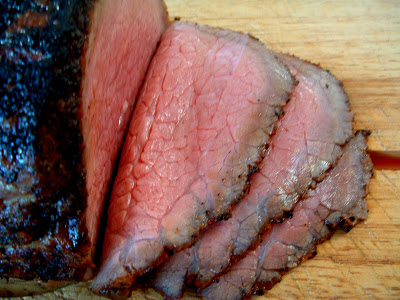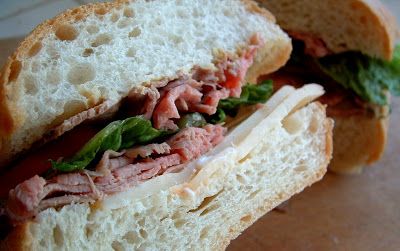Cooks Illuatrated March 2009 Beef Tenderloin Recipe

I am a huge fan of roast beef sandwiches. I prefer that my roast beef is rare, while my husband prefers medium. Either way, a fresh sourdough roll with mayo and deli mustard, Swiss cheese and sweet pickles is my winning formula.
NOTE UPDATE ON JULY 1, 2014: Wow! This photo has gone viral on Reddit! It's funny to read the comments– that this meat is raw. It's fake. It has face with a tongue sticking out (funny, and true…never noticed that before.) Let me say one thing– this roast beef was bomb-diggity. Yes. it's cooked exactly the way I like it! If it's too rare for y'all, then cook it some more. One person said it would dry up in 10 minutes and be a dry roast. Nope. Didn't happen. Anyway– welcome Reddit Army! I'm cooking for real, without any photo shopping. Please be nice, and not steal this photo without linking back to this blog. I have some work to do, as I see it's been done. Thank you!
The problem is finding good deli roast beef. I often wonder how long the beef has been in it's shrink wrap package, and I prefer to eat grass-fed beef. I spotted a recipe in a food magazine (and I won't name it) for Salt-Encrusted Beef. I've always wanted to try the technique of making a salt-flour dough and wrapping it around beef. The magazine photo looked delicious. But…

..I ended up with an unappetizing piece of gray meat. I was so disappointed that even though I had cooked the meat to 130F, the meat continued to cook until it was well past done! Contrary to the recipe, I should have taken the meat out at 120F, and maybe I would have had better luck. In short, this recipe was a total bust, and I ended up caramelizing a lot of onion so I could make a palatable sandwich out of gray shoe leather. Unfortunately, the meat was very dry and I never posted that recipe. You can thank me for that!
While flipping through one of my many Cook's Illustrated cookbooks, this version of Slow Roasted Beef (January 2008) caught my attention. I always enjoy reading the article that precedes their recipes because Cook's Illustrated does a lot of homework to perfect each recipe– and I have to say that I have yet to be disappointed. Here's a portion of the article, so that you can understand why this recipe worked:
First step: selecting the best cut for our roast. Our favorite, the eye-round, has good flavor and tenderness and a uniform shape that guarantees even cooking. Next step: choosing between the two classic methods for roasting meat—high and fast or low and slow. Low temperature was the way to go. Keeping the meat's internal temperature below 122 degrees as long as possible allowed the meat's enzymes to act as natural tenderizers, breaking down its tough connective tissue (this action stops at 122 degrees). Since most ovens don't heat below 200 degrees, we needed to devise a special method to lengthen this tenderizing period. We roasted the meat at 225 degrees (after searing it to give the meat a crusty exterior) and shut off the oven when the roast reached 115 degrees. The meat stayed below 122 degrees an extra 30 minutes, allowing the enzymes to continue their work before the temperature reached 130 degrees for medium-rare. Final step: seasoning. Salting the meat a full 24 hours before roasting made it even more tender and seasoned the roast throughout.
I made this recipe several months ago, but I wasn't thrilled with the photos. Since I'm home, healing from a winter cold, I'm editing some of the numerous food photos that I've been too busy to work on. I'm going to make this again, so I thought I'd share it with you– overexposed photos and all…

On Cook's Illustrated's recommendation, I bought 2 pounds of grass-fed eye-round. The cost was $5.99 per pound, and I think it's well worth it. Grass-fed beef is leaner, by the way. It also tastes better, has a nice texture to it and it's hormone-free. What's not to love about that?

Sprinkle all sides of roast evenly with salt. Wrap with plastic wrap and refrigerate 18 to 24 hours.

Pat roast dry with paper towels; rub with 2 teaspoons oil and sprinkle all sides evenly with pepper.

Heat remaining tablespoon oil in 12-inch skillet over medium-high heat until starting to smoke. Sear roast until browned on all sides, 3 to 4 minutes per side.(Sorry, the shot is a bit out of focus. I was using my older camera, which didn't shoot well in low light.) Now, Roast until meat-probe thermometer or instant-read thermometer inserted into center of roast registers 115 degrees for medium-rare, 1 1/4 to 1 3/4 hours, or 125 degrees for medium, 1 3/4 to 2 1/4 hours.
Turn oven off; leave roast in oven, without opening door, until meat-probe thermometer or instant-read thermometer inserted into center of roast registers 130 degrees for medium-rare or 140 degrees for medium, 30 to 50 minutes longer.

I have to say that my therma pen is one of my many favorite kitchen tools . It's accurate and has saved me from overcooking a lot of meat dishes! Now, that's what we're talking about! The color is beautiful and appetizing. Transfer roast to carving board and let rest 15 minutes.

Slice meat crosswise as thinly as possible and serve. The beef was juicy and flavorful. Next time, I'm adding garlic powder to give it more of an Italian flair.
This would be excellent served with creamy mashed potatoes and peas– how traditional is that? This roast beef was destined for sandwiches….

I'm not thrilled with how the sandwich photo turned out. You'll have to take my word that I am very pleased to be able to make my own roast beef, at home. My hat's off to Cook's Illustrated. This one is a winner. In a way, this beef reminds me of the Santa Maria Tri-Tip recipe (without the unique smokey flavor) that I got from Cook's Illustrated. It's too cold to grill, so an oven method like this is a great winter substitute.
Slow Roasted Beef
Using a fairly inexpensive cut of beef (eye-round) and roasting it low and slow yielded a flavorful and very juicy roast. This would be perfect for a Sunday dinner, but I roasted this to make roast beef sandwiches. Plan to make this one day before roasting, as salting the meat a full 24 hours before roasting made it even more tender and seasoned the roast throughout. Once again, Cook's Illustrated has perfected the art to flavorful roast beef.
Servings: 10
Calories: 133 kcal
- 1 3.5- to 4.5-pound boneless eye-round roast
- 4 teaspoons kosher salt or 2 teaspoons table salt
- 2 teaspoons plus 1 tablespoon vegetable oil separated
- 2 teaspoons ground black pepper
-
Sprinkle all sides of roast evenly with salt. Wrap with plastic wrap and refrigerate 18 to 24 hours.
-
Adjust oven rack to middle position and heat oven to 225°F.
-
Pat roast dry with paper towels; rub with 2 teaspoons oil and sprinkle all sides evenly with pepper. Heat remaining tablespoon oil in 12-inch skillet over medium-high heat until starting to smoke.
-
Sear roast until browned on all sides, 3 to 4 minutes per side. Transfer roast to wire rack set in rimmed baking sheet.
-
Roast until meat-probe thermometer or instant-read thermometer inserted into center of roast registers 115°F for medium-rare, 1 1/4 to 1 3/4 hours, or 125°F for medium, 1 3/4 to 2 1/4 hours.
-
Turn oven off; leave roast in oven, without opening door, until meat-probe thermometer or instant-read thermometer inserted into center of roast registers 130°F for medium-rare or 140°F for medium, 30 to 50 minutes longer. Transfer roast to carving board and let rest 15 minutes.
-
Slice meat crosswise as thinly as possible and serve.
We don't recommend cooking this roast past medium. Open the oven door as little as possible and remove the roast from the oven while taking its temperature. If the roast has not reached the desired temperature in the time specified in step 3, heat the oven to 225°F for 5 minutes, shut it off, and continue to cook the roast to the desired temperature. For a smaller (2 1/2- to 3 1/2-pound) roast, reduce the amount of kosher salt to 3 teaspoons (1 1/2 teaspoons table salt) and black pepper to 1 1/2 teaspoons. For a 4 1/2- to 6-pound roast, cut in half crosswise before cooking to create 2 smaller roasts. Slice the roast as thinly as possible and serve with Horseradish Cream Sauce ), if desired.
Recipe source: Cook's Illustrated

Source: https://afeastfortheeyes.net/2011/01/slow-roasted-beef-cooks-illustrated.html
0 Response to "Cooks Illuatrated March 2009 Beef Tenderloin Recipe"
Post a Comment